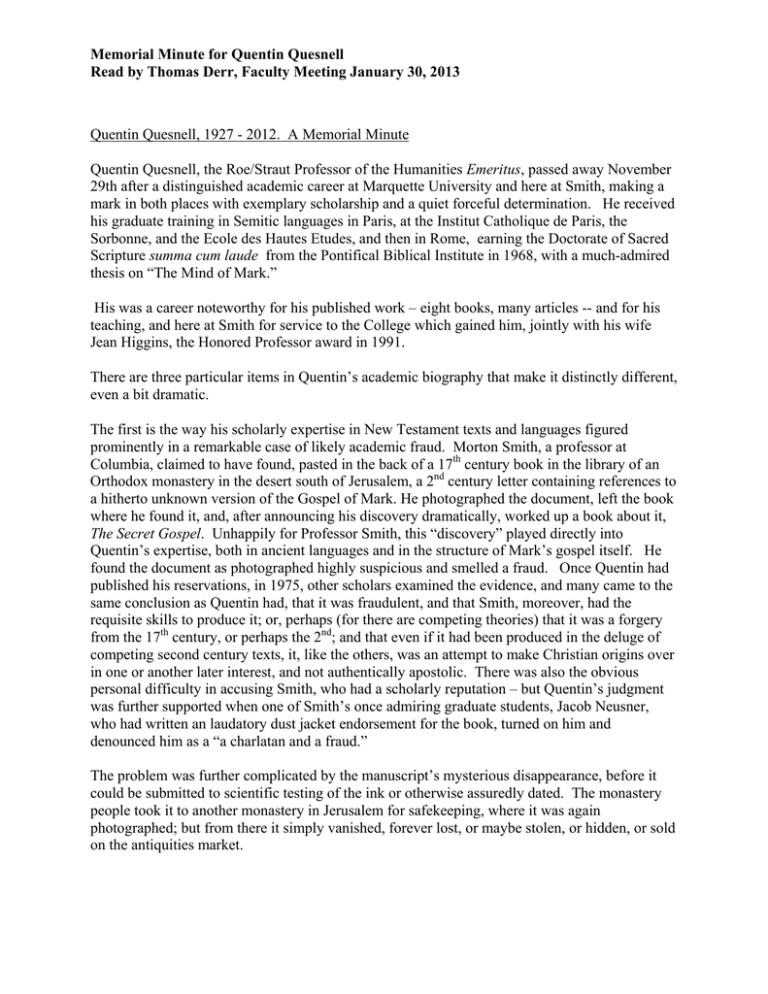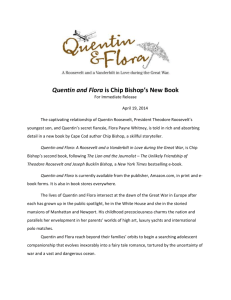Memorial Minute for Quentin Quesnell
advertisement

Memorial Minute for Quentin Quesnell Read by Thomas Derr, Faculty Meeting January 30, 2013 Quentin Quesnell, 1927 - 2012. A Memorial Minute Quentin Quesnell, the Roe/Straut Professor of the Humanities Emeritus, passed away November 29th after a distinguished academic career at Marquette University and here at Smith, making a mark in both places with exemplary scholarship and a quiet forceful determination. He received his graduate training in Semitic languages in Paris, at the Institut Catholique de Paris, the Sorbonne, and the Ecole des Hautes Etudes, and then in Rome, earning the Doctorate of Sacred Scripture summa cum laude from the Pontifical Biblical Institute in 1968, with a much-admired thesis on “The Mind of Mark.” His was a career noteworthy for his published work – eight books, many articles -- and for his teaching, and here at Smith for service to the College which gained him, jointly with his wife Jean Higgins, the Honored Professor award in 1991. There are three particular items in Quentin’s academic biography that make it distinctly different, even a bit dramatic. The first is the way his scholarly expertise in New Testament texts and languages figured prominently in a remarkable case of likely academic fraud. Morton Smith, a professor at Columbia, claimed to have found, pasted in the back of a 17th century book in the library of an Orthodox monastery in the desert south of Jerusalem, a 2nd century letter containing references to a hitherto unknown version of the Gospel of Mark. He photographed the document, left the book where he found it, and, after announcing his discovery dramatically, worked up a book about it, The Secret Gospel. Unhappily for Professor Smith, this “discovery” played directly into Quentin’s expertise, both in ancient languages and in the structure of Mark’s gospel itself. He found the document as photographed highly suspicious and smelled a fraud. Once Quentin had published his reservations, in 1975, other scholars examined the evidence, and many came to the same conclusion as Quentin had, that it was fraudulent, and that Smith, moreover, had the requisite skills to produce it; or, perhaps (for there are competing theories) that it was a forgery from the 17th century, or perhaps the 2nd; and that even if it had been produced in the deluge of competing second century texts, it, like the others, was an attempt to make Christian origins over in one or another later interest, and not authentically apostolic. There was also the obvious personal difficulty in accusing Smith, who had a scholarly reputation – but Quentin’s judgment was further supported when one of Smith’s once admiring graduate students, Jacob Neusner, who had written an laudatory dust jacket endorsement for the book, turned on him and denounced him as a “a charlatan and a fraud.” The problem was further complicated by the manuscript’s mysterious disappearance, before it could be submitted to scientific testing of the ink or otherwise assuredly dated. The monastery people took it to another monastery in Jerusalem for safekeeping, where it was again photographed; but from there it simply vanished, forever lost, or maybe stolen, or hidden, or sold on the antiquities market. Memorial Minute for Quentin Quesnell Read by Thomas Derr, Faculty Meeting January 30, 2013 The second unusual item in Quentin’s academic biography was his initiating a celebrated case about academic due process that earned Marquette censure by the AAUP. Quentin was a Jesuit while teaching at Marquette, which is a distinguished Jesuit university. An excellent teacher, he was honored by his colleagues, even serving as chair of the 30-member department of theology. But then he resigned from the Jesuits and was laicized so that he could marry Jean, who had been one of his graduate students, but had since finished her degree and found a position here at Smith. The university promptly fired him. Quentin asked for a hearing and was turned down, so he took his case to the AAUP, which appointed a distinguished committee to investigate. Marquette claimed that Quentin had held his position as a Jesuit, and in leaving the order, on his own initiative, had in effect resigned from the faculty, even though he had no intention of doing so and had tenure. There was also no written rule that resignation from the order meant resignation from the faculty, and there were already laicized priests, now married, on the faculty. The AAUP was not impressed by the university’s argument and found that the rules of tenure and due process had been violated because the administration had not allowed him a hearing before an appropriate faculty committee. Meanwhile, as the investigation proceeded, Smith College, and our Religion Department, solved the problem creatively by arranging for Quentin to come here and share Jean’s position, one of the first such arrangements here. That solution did not spare Marquette from its richly deserved censure by the AAUP, in 1976, a censure that the proud university bitterly resented. It remained on that blacklist for 21 years, only lifted in 1997 after it had altered its contract with the Jesuits so that a similar case could not arise again, and had demonstrated, to the AAUP’s satisfaction, a consistent record of protecting academic freedom – and of course Quentin’s appeal had long since become moot by his move to Smith. But his stand on principle made him many friends, including among the Marquette faculty, as I know. The third area of special notice in Quentin’s career is quite intra-mural. He turned his talents toward research into Smith College’s beginnings, which resulted first in an Engel lecture titled “In Search of Sophia.” It was not really about Sophia Smith, though it started there, but rather a learned exercise in the figure of Sophia, the Holy Wisdom, in text, art, and iconography, followed through ancient religions and extensively in Jewish and Christian development. He traced the course of this figure, in a thoughtful and imaginative way, right down to the adoption of our college seal and the motto on it. After the research for the Engel lecture he kept going, digging deeply into the early history of the college, eventually producing a book, The Strange Disappearance of Sophia Smith, arguing that her vision and contributions were later obscured by those of John M. Greene, who outlived her by half a century. Sophia died in 1870, a year before the college was chartered. Greene, who was the minister of her church in Hatfield and her friend, remained deeply involved with the college, at times, according to Quentin, even energetically disagreeing with President Seelye. Quentin had a hobby of local history beyond that of the early years of the college, for a while serving as the chair of the Northampton Historical Commission. He led a long and productive life, with surprising turns along the way. He was a man of many interests, all tied together by a passion for deep and thorough scholarship – in the fine Jesuit tradition.



